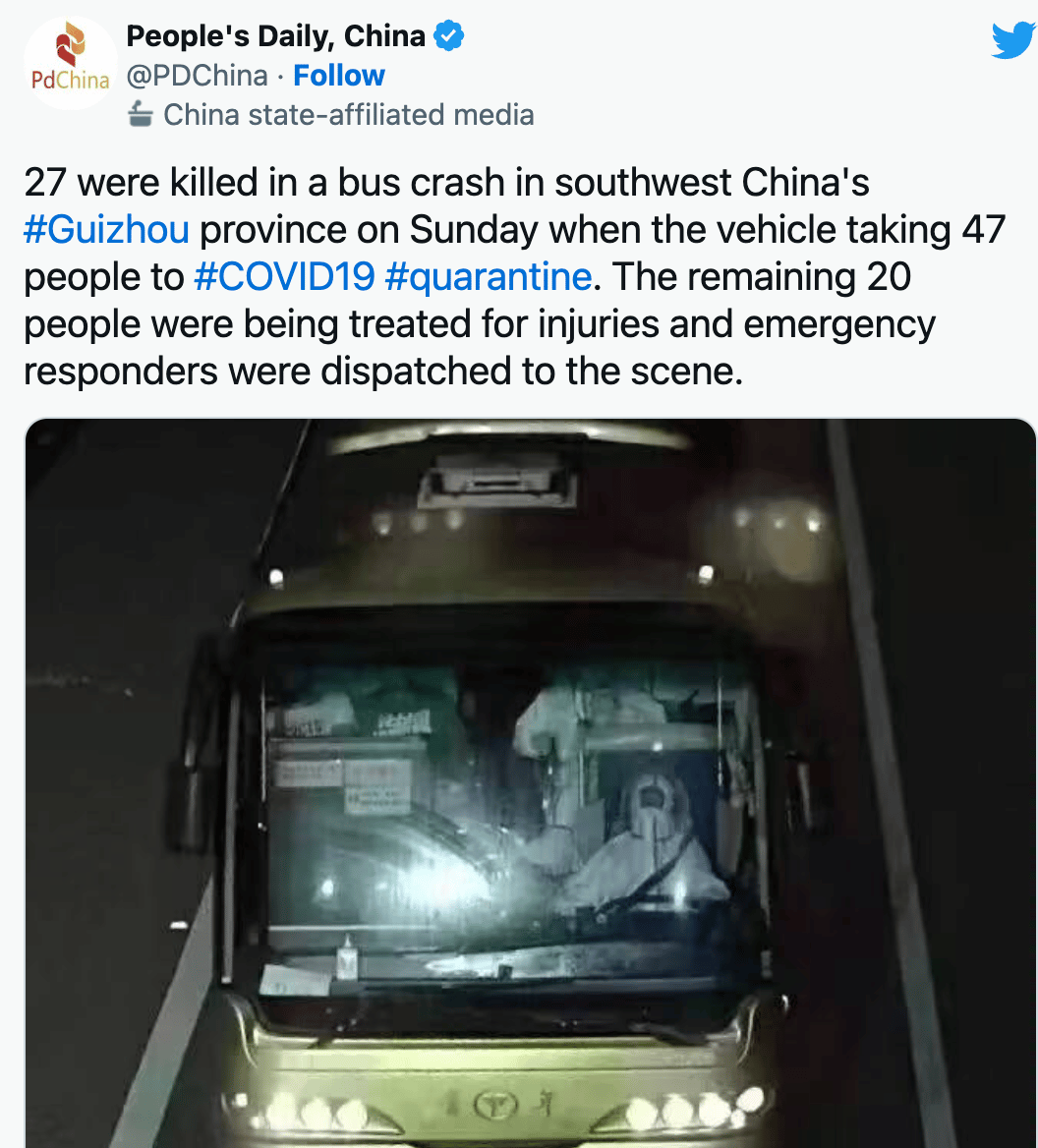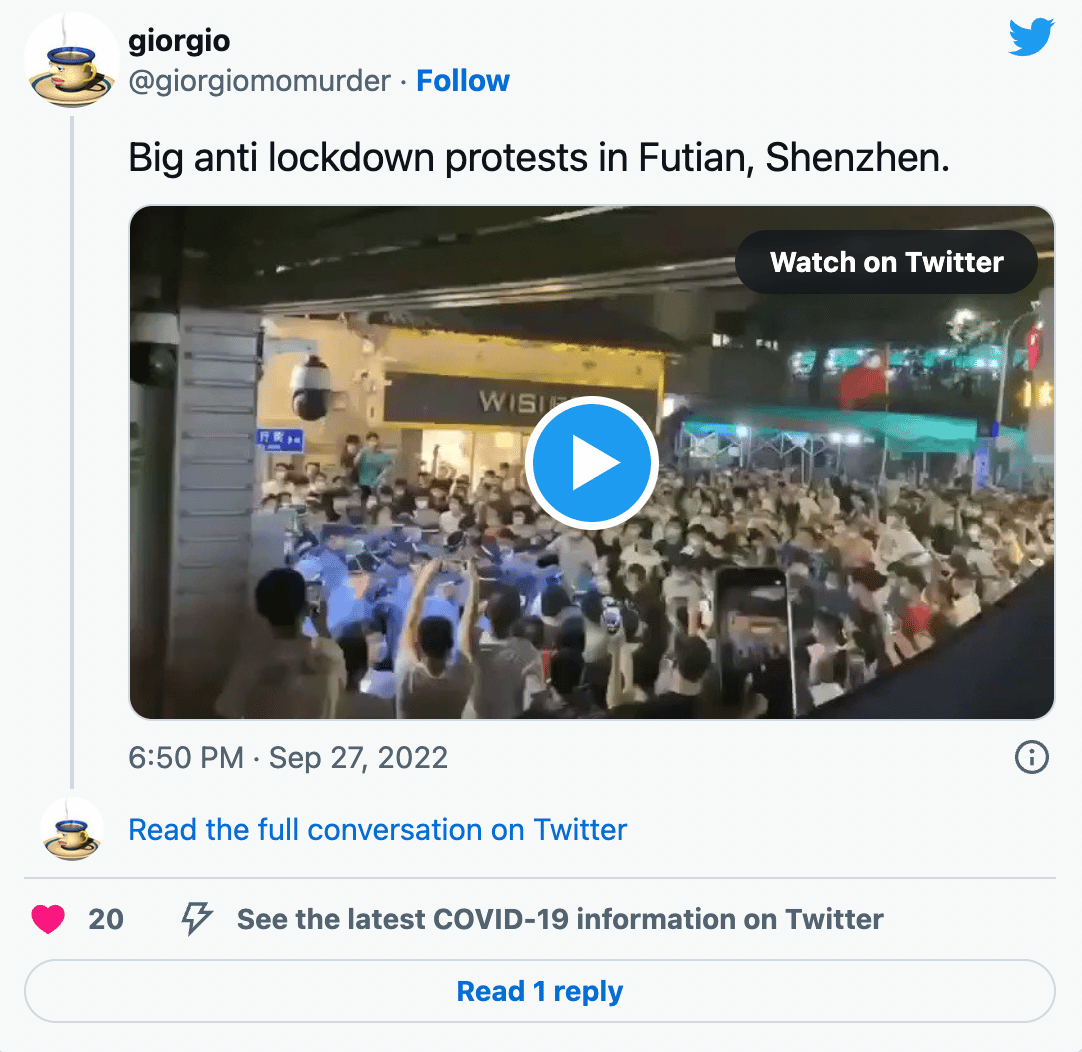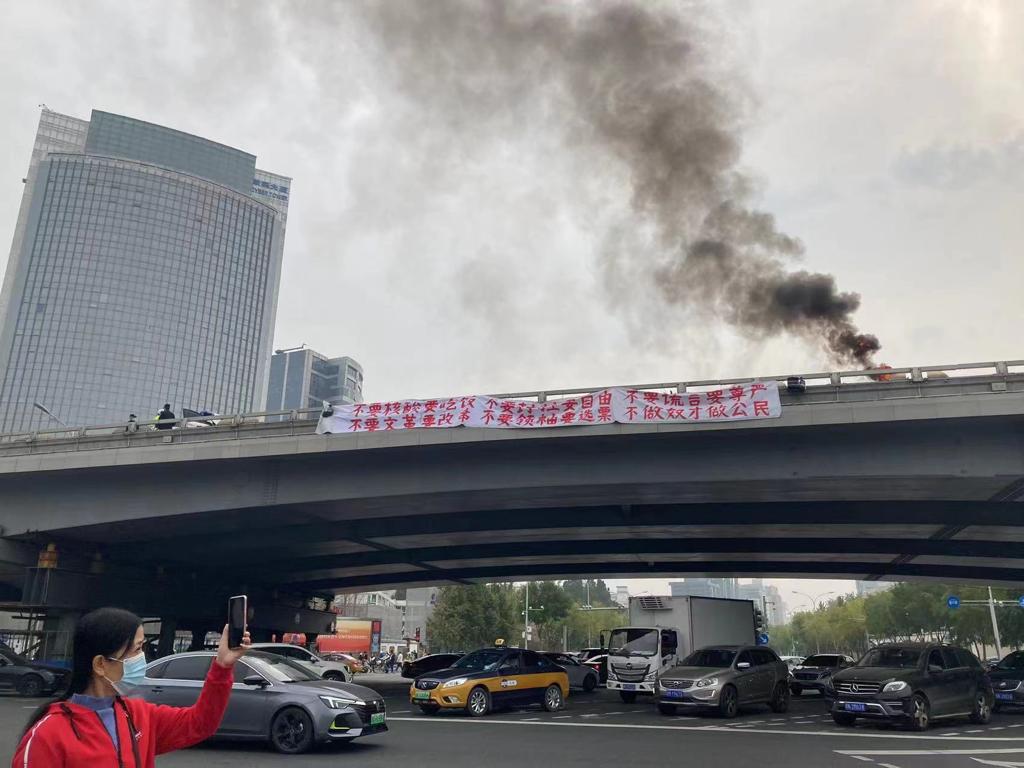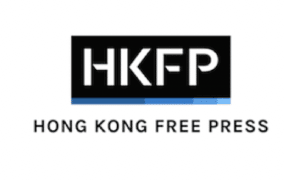Dissatisfaction with China’s strict anti-epidemic measures has been brewing for several months, with small protests – online and offline – emerging ahead of major events and after Covid-related tragedies.
Unprecedented protests in multiple Chinese cities and on university campuses have swept across the country in recent days, openly defying China’s stringent zero-Covid measures.
Public anger was ignited by a deadly fire in Urumqi and swiftly spread. However, there have been several occasions over the past few months that have suggested dissatisfaction with pandemic measures has been brewing.

HKFP looks at what led up to the nationwide demonstrations…
September 18: Quarantine bus crash
Twenty-seven people were killed when a bus taking them to a Covid-19 quarantine facility in southwest China’s Guizhou province crashed in September.

The incident sparked criticism of the nation’s rigid anti-epidemic measures online.
Late September: Shenzhen protest
A snap Covid-19 lockdown over a handful of infections in the tech hub Shenzhen sparked a protest in the city’s Futian district.

Videos circulating online after September 26 showed people calling for an end to lockdowns.
October 13: Beijing bridge protest
In the days running up to the 20th National Congress of the Chinese Communist Party, when Chinese leader Xi Jinping cemented a historic third term, a rare protest occurred in Beijing.
Banners were hung from Sitong Bridge, an overpass in the capital’s Haiding district. One of the banners, according to online images, called on people to go on strike to “oust the dictator, traitor Xi Jinping.”

Another banner meanwhile listed a range of grievances against the country’s stringent Covid-19 restrictions. “We want food, not PCR tests. We want freedom, not lockdowns. We want respect, not lies. We want reform, not Cultural Revolution. We want a vote, not a leader. We want to be citizens, not slaves,” it read.
The banners were quickly removed but photos were widely shared online. Chinese censors, however, were swift to take down social media posts related to the incident, including those with keywords such as #Haidian, #Sitong bridge, and even #Beijing.
Following the censorship, people used another hashtag – #ISawIt – to communicate on China’s Twitter-like Weibo platform. But those posts were also removed, with some reporting that their account was permanently blocked.
Late October onwards: Foxconn lockdown
A Covid-19 outbreak at a factory operated by Foxconn in the central city of Zhengzhou, which employs around 300,000 people and is known as the largest producer of iPhones in the world, sparked lockdowns, walkouts and later violent clashes between workers and police.
Footage of protests outside the factory were shared widely online in late November before the Weibo hashtag #Foxconnriots was apparently censored.
Mid-November: Guangzhou protest
Hundreds of people took to the streets of Guangzhou in southern China in opposition of strict Covid-19 measures, according to videos that emerged on social media on November 14.
Protesters in the locked down Haizhu district, home to many migrant workers, tore down cordons designed to keep residents from leaving their homes and chanted “no more testing.”
November 20: Maskless World Cup kicks off
Images of football fans – noticeably face mask-free – at the FIFA World Cup Qatar 2022 angered people in China still subject to Covid-19 restrictions.
Many took to social media to vent their frustrations, while an open letter questioning pandemic policies and asking if China was “on the same planet” as Qatar spread on the WeChat messaging app on November 22, before it was removed by censors.
Recent reports suggest that Chinese state broadcaster CCTV has started to censor match footage to deliberately avoid showing fans in the stadium.
November 24: Urumqi fire
A fire broke out in a residential block in Xinjiang’s capital Urumqi, claiming 10 lives and injuring nine.
As the city was locked down for over 100 days, members of the public blamed Covid-19 restrictions for hampering rescue efforts and people’s ability to escape.
Meanwhile, Urumqi authorities said the community where the fire broke out was categorised as a “low risk” area for Covid-19, and residents were allowed to leave their buildings.
November 25: Urumqi protest
Hundreds of residents took to the streets of Urumqi the night after the deadly blaze, demanding an end to the Covid-19 lockdown measures affecting the area.
One widely circulated video showed protesters gathered in front of a government building signing the national anthem, the “March of the Volunteers.”
They also shouted “serve the people” – a slogan used by former Chinese leader Mao Zedong and later adopted as a legal obligation for all Chinese Communist Party members and staff of the Chinese government.
The day after the protests, the city’s health authorities announced that restrictions in areas listed as “low risk” would be incrementally eased.
November 26: University action; Shanghai protest
From November 26, slogans and artworks protesting China’s stringent Covid-19 restrictions started to emerge across dozens of university campuses.
That evening, hundreds of students held up blank paper sheets and phone torches at the Communication University of China, Nanjing.
They shouted “long live the people, may the dead find eternal peace” in commemoration of those who died in the Urumqi fire and protested against China’s zero-Covid policies.
In the late hours of November 26, Shanghai residents started to gather around Wulumuqi Road, named for Urumqi in Mandarin, to hold silent vigils for victims of the blaze.
At around 2 a.m. on November 27, the crowds started to chant slogans after minor clashes between protesters and the police. People were heard shouting “we want freedom, not PCR tests,” “give me freedom, or give me death,” and “freedom of speech, press freedom.”
Later, some began chanting “Communist Party, step down,” and “Xi Jinping, step down!” Such explicit expressions of dissent are all but unheard of in contemporary mainland China.
The protest lasted until around 4 a.m. when police started to arrest the remaining protesters. According to Initium Media, at least eight were seen being apprehended by the police in available footage.
November 27 noon: Tsinghua University assembly
Hundreds of students of Beijing’s prestigious Tsinghua University held an assembly in support of the recent protests.
According to videos widely circulated on social media, the students chanted “democracy and rule of law, freedom of expression.”
A woman was filmed telling others that she would “regret it for the rest of my life” if she did not speak up.
November 27 evening: Rallies in multiple cities
In the evening of November 27, the wave of protests spilled into major cities across the country, including Beijing, Shanghai, Guangzhou, Wuhan and Chengdu.
Police in Shanghai began cordoning off sections of Wulumuqi Road but it did not stop people from rallying in the city. Online videos showed demonstrators repeating the slogans from Beijing’s Sitong Bridge banners.
“We want food, not PCR tests. We want freedom, not lockdowns. We want respect, not lies. We want reform, not Cultural Revolution. We want a vote, not a leader. We want to be citizens, not slaves,” they were heard chanting.
Meanwhile, residents of China’s capital city Beijing also rallied near the Liangma River to mourn the Urumqi fire casualties. They also brought along white placards and chanted slogans of support for those arrested in Shanghai.
Some Beijing protesters were filmed questioning the narrative that there were “foreign anti-China forces” within the rallying masses. “We can’t even browse foreign websites, how can we have foreign forces?” one asked.
In Guangzhou, crowds were heard singing Hong Kong rock band Beyond’s “Boundless Oceans, Vast Skies” together. The song was also adopted by Hong Kong’s pro-democracy protesters.
Read more and see images at
Timeline: Key dates in China’s ‘blank placard’ zero-Covid protests




